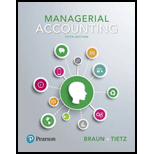
Continuation of E6-46B: High-low method (Learning Objective 4)
Refer to Lotta’s Fourth Street Floral data in E6-46B. Use the high-low method to determine the company’s cost equation for van operating costs. Use your results to predict van operating costs at a volume of 15,500 miles.
Tammy Lotta, owner of Fourth Street Floral, operates a local chain of floral shops. Each shop has its own delivery van. Instead of charging a flat delivery fee, Lotta wants to set the delivery fee based on the distance driven to deliver the flowers. Lotta wants to separate the fixed and variable portions of her van operating costs so that she has a better idea of how delivery distance affects these costs. She has the following data from the past seven months:
| Month | Miles Driven | Van Operating Costs |
| January | 15,800 | $5,460 |
| February | 17,300 | $5,680 |
| March | 14,600 | $4,940 |
| April | 16,000 | $5,310 |
| May | 17,100 | $5,830 |
| June | 15,400 | $5,420 |
| July | 14,100 | $4,880 |
Want to see the full answer?
Check out a sample textbook solution
Chapter 6 Solutions
Managerial Accounting (5th Edition)
- Please provide the answer to this general accounting question with proper steps.arrow_forwardI am trying to find the accurate solution to this general accounting problem with the correct explanation.arrow_forwardPlease provide the answer to this general accounting question with proper steps.arrow_forward
- Please help me solve this general accounting question using the right accounting principles.arrow_forwardCan you help me solve this financial accounting question using the correct financial procedures?arrow_forwardCan you help me solve this general accounting problem with the correct methodology?arrow_forward
 Managerial Accounting: The Cornerstone of Busines...AccountingISBN:9781337115773Author:Maryanne M. Mowen, Don R. Hansen, Dan L. HeitgerPublisher:Cengage Learning
Managerial Accounting: The Cornerstone of Busines...AccountingISBN:9781337115773Author:Maryanne M. Mowen, Don R. Hansen, Dan L. HeitgerPublisher:Cengage Learning Cornerstones of Cost Management (Cornerstones Ser...AccountingISBN:9781305970663Author:Don R. Hansen, Maryanne M. MowenPublisher:Cengage Learning
Cornerstones of Cost Management (Cornerstones Ser...AccountingISBN:9781305970663Author:Don R. Hansen, Maryanne M. MowenPublisher:Cengage Learning Essentials of Business Analytics (MindTap Course ...StatisticsISBN:9781305627734Author:Jeffrey D. Camm, James J. Cochran, Michael J. Fry, Jeffrey W. Ohlmann, David R. AndersonPublisher:Cengage Learning
Essentials of Business Analytics (MindTap Course ...StatisticsISBN:9781305627734Author:Jeffrey D. Camm, James J. Cochran, Michael J. Fry, Jeffrey W. Ohlmann, David R. AndersonPublisher:Cengage Learning


